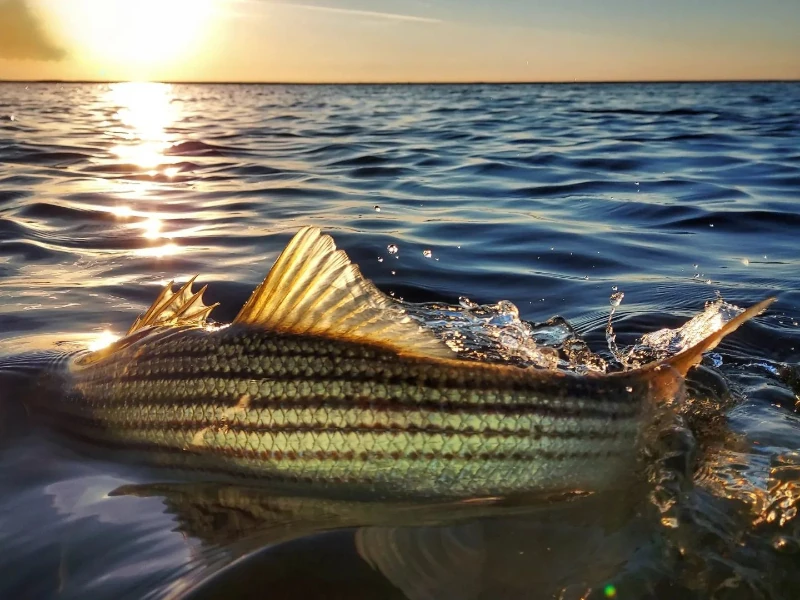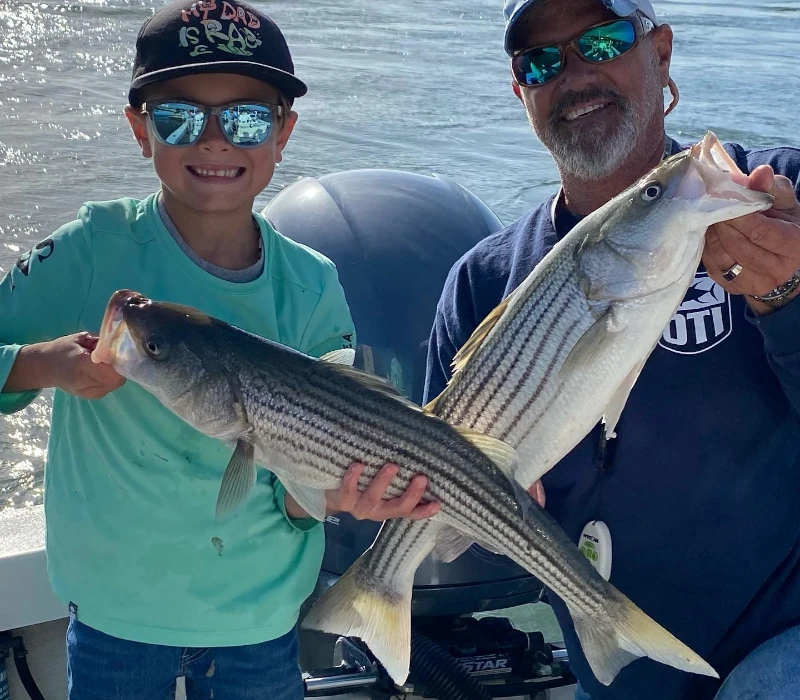Fall Migration of Striped Bass
Posted by TackleDirect on Nov 8th 2023

Learn about the fall striper migration and how to follow it for successful days out on the water. Use this guide from TackleDirect for tips on locations, technique and more.
Fall Striper Migration
When the leaves change color, it’s time for Northeast anglers to start gearing up for the year’s best striper fishing. If you’re a veteran angler on the East Coast, you’ve almost certainly seen the fall striper run. This striped bass migration sees them head from the shores of Northern New England down to the mid-Atlantic for the winter — gobbling up baitfish along the way. Some have reported seeing swathes of stripers a quarter mile long and the width of a football field!
Those who love to catch striped bass, whether for sport or their dinner table, have a golden chance during the migration to land a few trophies. And if you’re willing to travel a little, you can enjoy up to four months of prime striper fishing. The expert anglers at TackleDirect are here with some tips for fishing the fall striped bass migration.

Close-up of a striped bass
Where to Fish for Striper in the Fall
The migration typically begins in early September and can last as late as Christmas, depending on when the water temperatures change. In late September and early October, striper populations peak in Southern Maine, New Hampshire, Rhode Island, and Eastern Connecticut. Throughout mid-October to early November, Long Island is the place to go. Stripers start reaching the northernmost parts of New Jersey in late October. In late November and December, they pass by Southern New Jersey and Eastern Delaware before reaching their winter homes off Maryland and Virginia. The migration's path can be summarized as follows:
- Late September and early October: Peak striper populations can be found in Southern Maine, New Hampshire, Rhode Island, and Eastern Connecticut.
- Mid-October to early November: Long Island becomes a hotspot for striper fishing.
- Late October: Stripers start reaching the northernmost parts of New Jersey.
- Late November and December: Stripers pass through Southern New Jersey and Eastern Delaware before reaching their winter habitats off Maryland and Virginia.
The one exception to this geographic path is Boston and Cape Cod, with peak migration happening throughout September. This is because the waters in these areas are a popular summer home for striped bass. As such, their role in the migration is more like that of Northern Maine, with fish staging as early as late August to make their departure. Also, since the waters are warmer, some stripers will hang around longer, so determined fishermen can still land nice catches around Boston as late as Thanksgiving.

Close-up of a striped bass at sunset
Striped Bass Migration Fishing Tips
As mentioned, the fall striper blitz stays along the shorelines, making it relatively easy to track. Casting and fly fishing with topwaters, swimbaits or plugs are good since migrating stripers tend to hang out near the surface. Surf-casting and jigging are also viable techniques if you want more control over depth. While any place along the beach can be fruitful when there are 100,000 stripers passing through, your best bet is to go where the baitfish are. In other words, look for sinking tides and edges that produce warmer water. This includes depth changes, structures and drop-offs.
Choice of Lures & Techniques
Casting and fly fishing with topwaters, swimbaits, or plugs are effective techniques since migrating stripers tend to congregate near the surface. Surf-casting and jigging are also viable options if you want more control over the depth you're fishing at.
- Topwaters: Topwater lures are designed to work along the surface, creating splashes and commotion that attract the attention of feeding stripers. These lures mimic injured or struggling baitfish, making them irresistible to hungry stripers. When stripers are close to the surface during their migration, or you find a wide open blitz, topwater lures can yield exciting strikes and visual action.
- Swim Shads: Swim shads are soft plastic lures that imitate the look and swimming motion of bunker. These lures come in various sizes, allowing anglers to match the size to what is running locally.
- Surf-Casting: Surf-casting involves using longer rods and heavy-duty reels to cast lures or bait further into the surf. It's an effective method when stripers are cruising in the breakers or near the shoreline. You can use a variety of lures and bait with this technique, depending on the specific conditions and the depth at which the stripers are feeding.
- Jigging: Jigging is a technique that involves vertically presenting lures or jigs to fish at various depths. It allows anglers to control the depth at which they are fishing, making it suitable for targeting stripers that may be holding at different levels in the water column. Jigging can be particularly effective when stripers are near underwater structures or drop-offs.
- Trolling: Trolling is a popular technique for covering water and finding fish that are not visibly present on the surface or when the bite is slower on that particular day. Mojos, umbrella rigs, and lipped diving plugs are the most popular options used to target striped bass on the troll.
Location Matters:
While stripers can be found along various parts of the beach during this migration, it's essential to go where the baitfish are. Look for sinking tides, edges, and features that produce warmer water, such as depth changes, underwater structures, and drop-offs.
- Sinking Tides: Stripers tend to follow the tide as they hunt for baitfish. Focus your fishing efforts during times of sinking tides, as this is when baitfish are often pushed into channels and along the edges. Stripers use these areas to ambush their prey, making it a prime location for anglers.
- Depth Changes: Pay attention to areas with depth changes, as they can create turbulence and concentration of baitfish. Stripers are likely to gather around these features to take advantage of the disoriented bait.
- Underwater Structures: Rocks, reefs, piers, and other underwater structures provide shelter for baitfish and create ideal hunting grounds for stripers. Fishing near these structures can increase your chances of success.
- Drop-offs: Drop-offs, where the bottom suddenly descends to greater depths, can be magnets for stripers. These locations offer both cover for baitfish and ambush points for stripers.
- Birds: Keep an eye for bird play, as this will be your indicator that bait and hopefully fish, are in the area.
Matching Lures to Baitfish:
Migrating stripers are voracious feeders, and the key is to match your lures to the local baitfish species. The most common baitfish that fuel the fall migration are bunker (menhaden), mackerel, and sandeels.

Two striped bass
Want a chance at getting your fishing image featured?
Just Tag Your Next Catch With #HookedOnTD.
Head on over to the for more details.
